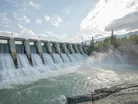Global reservoir volumes fall despite construction boom

Global reservoir volumes have been consistently falling over the last 20 years despite a construction boom that drove up storage capacity. A NASA-funded report conducted by Texas A&M University has suggested that new dams will not be enough to solve the growing strain on the world’s water supplies.
Reservoirs worldwide have become increasingly empty despite construction of new reservoirs. Led by Dr. Huilin Gao, associate professor at Texas A&M University, researchers used a new approach with satellite data to estimate the storage variations of 7,245 global reservoirs from 1999 to 2018.
Climate change is a “critical factor”
The report has been published in Nature Communications and suggests that surface water reservoirs are being increasingly relied upon to meet rising demands due to continuously growing populations and climate change.
However, the amount of water available in such reservoirs has not been well quantified at the global scale, according to Texas A&M University.
Lead author of the report Huilin Gao stated that “as the global population continues to grow in the 21st century, surface water reservoirs are increasingly being relied on to meet rising demands in the context of a changing climate.
“However, the amount of water available in reservoirs and its trends have not been well quantified at the global scale.”
She added that climate change was a "critical factor" in reducing reservoir efficiency, but that rising water demand also played a role.
"Even if temperatures stop rising, increasing demand and new construction are likely to continue," she added.
Projected trends as a result of this research suggest that water runoff will only continue to decline, in conjunction with rising water demand, potentially resulting in significant implications on water supplies.
The findings of this report indicate that addressing future water demands cannot rely solely on constructing new reservoirs and emphasises the need for more novel management strategies.
Mitigating water inequities
The decline in reservoir storage is especially prominent in South Asia, Africa and South America. Although efforts are being made to construct new reservoirs, the data in the report shows that they are falling short of expected filling levels.
South America and Africa have been particularly affected by the decline, which the report suggests is due to growing populations contributing to an escalated water demand.
In contrast, the report has suggested that reservoirs in regions such as North America and Europe are experiencing upward trends in reaching maximum capacity. Reservoirs in high-latitude regions such as the Great Lakes and Siberia have higher storage capacities which has been attributed to their lower population densities and less impact from human activity.
“Through this research, we share a new perspective for reevaluating the socio-economic benefits of new reservoir construction and the tension between growing water demand and lessening water availability in developing countries,” said Dr. Yao Li, a Texas A&M former postdoctoral researcher who is currently a professor at the School of Geographical Sciences at Southwest University.
The International Hydropower Association stated, as reported by The Japan Times, that new dams and reservoirs played a “crucial mitigating role in an era of increasing climate extremes,” making it easier to regulate water flows.
“As the climate gets more volatile, we will need more, not less, water infrastructure, with the bonus of much-needed low-carbon electricity.”
- How Is Amazon's Mass Timber Station Aiding Sustainability?Sustainability & Green Building
- Global Coalition Targets Green Finance for Building SectorSustainability & Green Building
- Skanska and Holcim Lead Low-Carbon Road Building RevolutionSustainability & Green Building
- Explainer: Formwork - Shaping the Future of ConstructionBuilt Environment




